Giochi dell'Oca e di percorso
(by Luigi Ciompi & Adrian Seville)
(by Luigi Ciompi & Adrian Seville)

|
Giochi dell'Oca e di percorso
(by Luigi Ciompi & Adrian Seville) |

|
 |

Torna alla ricerca giochi (back to game search) |
 |
| Laurie and Whittle's New Moral and Entertaining Game of The Mansion of Happiness | ||
| Invented by George Fox, W.M., author of "The Cottagers" and various Poetical Pieces. | ||
 |
Versione stampabile
 |
Invia una segnalazione

|
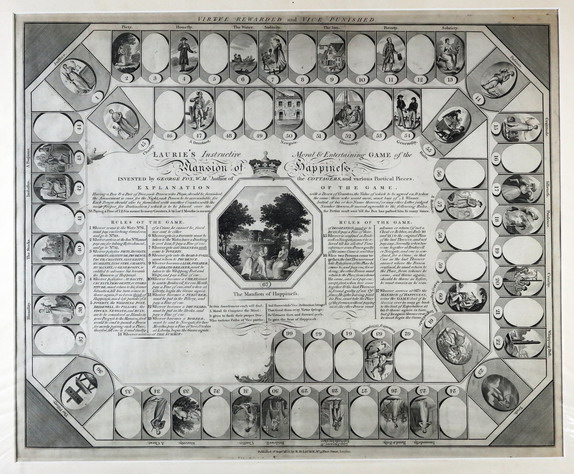 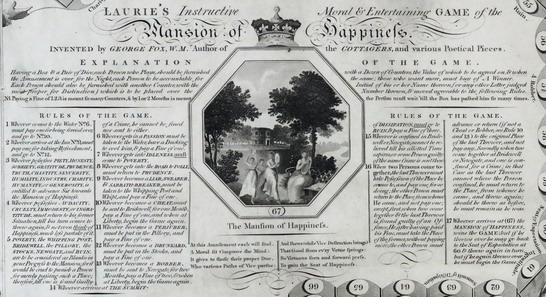 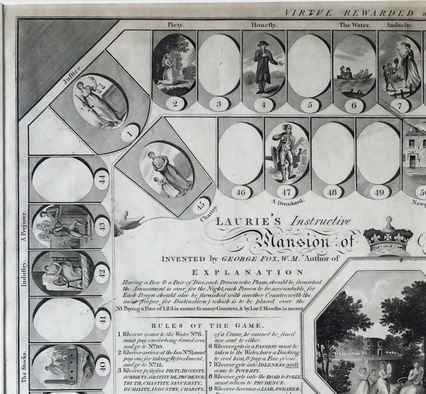 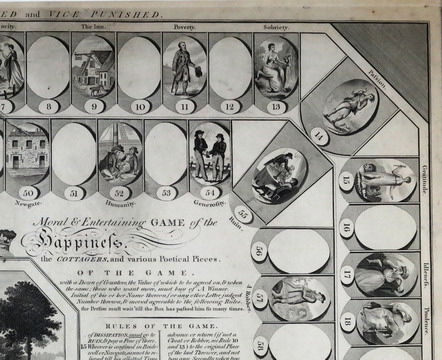 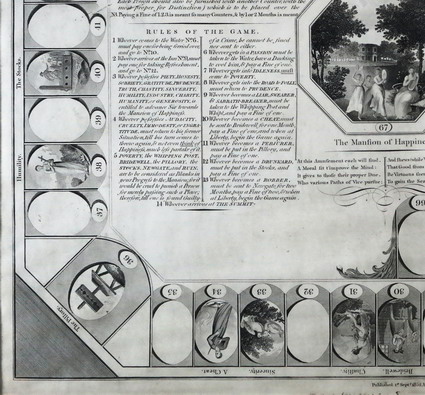 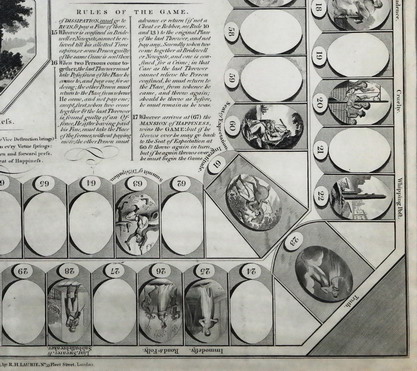 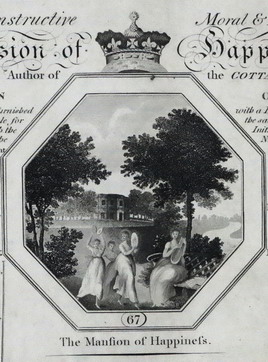 |
primo autore: | Fox George |
| secondo autore: | Laurie Richard Holmes | |
| anno: | 1800 | |
| luogo: |
Inghilterra-Londra |
|
| periodo: | XIX secolo (1°/4) | |
| percorso: | Percorso di 67 caselle numerate | |
| materiale: | carta incollata su tela (engraving on paper with linen backing) | |
| dimensioni: | 472X580 | |
| stampa: | Litografia colorata (hand coloured engraving) | |
| luogo acquisto: | ||
| data acquisto: | ||
| dimensioni confezione: | ||
| numero caselle: | 67 | |
| categoria: | Infanzia, educazione, pedagogia, favole e fiabe | |
| tipo di gioco: | Gioco di percorso | |
| editore: | Published 13th October, 1800 by Robert Laurie & James Whittle, No 53 Fleet Street, London. | |
| stampatore: | Published 13th October, 1800 by Robert Laurie & James Whittle, No 53 Fleet Street, London. | |
| proprietario: | Collezione Privata | |
| autore delle foto: | L. Ciompi - A. Seville | |
| numero di catalogo: | 1385 | |
| descrizione: |
Gioco di 67 caselle numerate, spirale, orario, centripeto. Questo gioco ha ispirato la versione americana pubblicata da W&S B Ives nel 1843 ((Arch. n°422). L'inventore è "George Fox, W. M. autore di The Cottagers e vari pezzi poetici" che ha inventato anche un altro gioco morale, "The Reward of Merit", pubblicato da John Harris e John Wallis nel 1801. Il gioco è dedicato alla Duchessa di York (Principessa Frederica Charlotte di Prussia [1767–1820]) e la stessa "Mansion of Happiness" è una rappresentazione di Oatlands Park, la residenza in cui si ritirò dopo il fallimento del suo matrimonio con il duca. Vedi anche la versione reimpostata stampata da Laurie il 1°settembre del 1851. REGOLE: al centro. CASELLE: mute. REFERENZA 1 "Laurie and Whittle's New Moral and Entertaining Game of The Mansion of Happiness". (V&A Museum). The publishers dedicated this game to the then Duchess of York, and the Mansion of Happiness itself is a representation of Oatlands Park, the residence of the Duke of York. The game is very strict compared to other moral games of the same period. The crimes are serious-theft, lying, drunkenness, cheating--and the punishments include prison sentences, whipping, the stocks and ducking: "Whoever gets into a Passion must be taken to the Water, have a ducking to cool him and pay a fine of one." While most early board games bear the names of the publishers and the date of publication, few indicate any inventor if, of course, there was one. The Mansion of Happiness however does have an inventor, George Fox. A version of this game is considered to be the first board game produced in the United States, published by W&S B Ives in 1843. Physical description Design: engraving, coloured by hand; 12 sections mounted on linen showing 66 compartments representing virtues and vices with Oakland park in the centre; clockwise from top left corner N°of squares: 67 Squares illustrated: all Square numbering: 1 to 67 Squares titled: all Subject of starting square: Justice Subject of ending square: Mansion of Happiness Place of Origin: London Date: 13/10/1800 Artist/maker: R. H. Laurie Materials and Techniques: Hand-coloured engraving on linen Dimensions: Height: 47.2 cm; width: 58 cm Object history note: US version published by W & SB Ives Company, 1843; thought to be the first US board game. Ives also assumed the title of first to invent folding boards but these were in existence in England and Europe before this date. Historical context note Rewards: receipt of counters, forward movements, extra turns Forfeits: payment of counters, backward movement, missing turns N°of Players: any Equipment required: dice, markers and counters Rules: EXPLANATION OF THE GAME Having a box and a pair of dice, each person who plays, should be furnished with a dozen counters, the value of which is to be agreed on and when the Amusement is over for the night, each person is to be accountable for the same, those who want more must buy a winner. Each person should also be furnished with another counter with the initial of his/her name thereon (or any other letter judged most proper for distinction) which is to be placed over the number thrown and moved agreeable to the following rules: N.B. Paying a fine of 1,2,3 is meant so many counters and by 1 or 2 months is meant the person must wait 'till the box has passed him so many times. RULES OF THE GAME 1. Whoever comes to the Water No 6 must pay one for being ferried over and go to No. 10. 2. Whoever arrives at the Inn No 9 must pay one for taking refreshments and go to No. 12. 3. Whoever posseses Piety, Honesty, Sobriety, Gratitude, Prudence, Truth Chastity, Sincerity, Humility, Industry, Charity, Humanity, Generosity is entitled to advance six towards the Mansion of Happiness. 4. Whoever posses Audacity, Cruelity, Immodesty or Ingratitude must return to his former situation, till his turn comes to throw again and not even think of happiness much less partake of it. 5. Poverty, the Whipping Post, Bridewell, the Pillory, the Stocks, Newgate, and Ruin are to be considered as blanks in your progress to the Mansion: for it would be cruel to punish a person merely passing such a place; therefore, till one is found guilty of a crime, he cannot be fined or sent to either. 6. Whoever gets in a Passion must be taken to the Water, have a ducking to cool him and pay a fine of one. 7. Whoever gets into Idleness must come to Poverty. 8. Whoever gets into the Road to Folly must return to Prudence. 9. Whoever becomes a Liar, Swearer and Breaker of the Sabbath, must be taken to the Whipping Post and Whipt, and pay a fine of one. 10. Whoever becomes a Cheat, must be sent to Bridewell for one moth, pay a fine of one and when at liberty begin the game again. 11. Whoever becomes a Perjurer must be put in the Pillory and pay a fine of one. 12. Whoever becomes a drunkard, must be put in the stocks and pay a fine of one. 13. Whoever becomes a robber must be sent to Newgate for two months, pay a fine of two and when at liberty begin the game again. 14. Whoever arrives at the summit of dissipation, must go to ruin and pay a fine of three. 15. Whoever is confined to Bridewell or Newgate, cannot be relieved till his allotted time expires or some person guilty of the same crime is sent there. 16. When two persons come together, the last thrower must take possession of the place from whence he came and not pay one; except, first, when two come together and the last thrower is found guilty of an offence, He after having pad his fine, must take the place of the former, without paying more; the other person must advance or return (if not a cheat or robber, see rule 10 and 13) to the original place of the last thrower, and not pay any. - Secondly when two come together at Bridewell or Newgate, and one is confined for a crime; in that case as the last thrower cannot relieve the person confined, he must return to the place from whence he cane and throw again, before he must remain as he was. 17. Whoever arrives at 67 The Mansion of Happiness, wins the game; but if he throws over he must begin the game again. Under the central compartment is an eight line verse about vice and virtue. Note: The publishers dedicated the game to the Duchess of York, 1800, and the Mansion of Happiness is a representation of Oatlands Park, the residence of the Duke of York. *While most early board games bear the names of the publishers and the date of publishcation, few attest to the actual inventer if, of course, there was one. However, within the space of about one year, two moral games were `invented' by one man, George Fox, although the publishers of the games differ. The first game, THE MANSION OF HAPPINESS, is a hand coloured engraving published by Laurie and Whittle on 13/10/1800 with 67 compartments, which represent various virtues and vices together with, in the centre, 67, a view of Oaklands Park. The game is very harch compared with the others. The "crimes" are serious - theft, lying, drunkenness, cheating - and the punishments include prison sentences, whipping, the stocks and ducking - "Whoever gets into a Passion must be taken to the Water, have a ducking tocool him and pay a fine of one." Rules placement: on either side of the centre illustration. Descriptive line: Hand coloured moral race game, The Mansion of Happiness, published in England by Laurie & Whittle in 1800. REFERENZA 2 WHITEHOUSE, Francis Reginald Beaman, (pag. 51): MANSION OF HAPPINESS Laurie & Whittle’s New, Moral and Entertaining game of. Invented by George Fox, W.M., author of "The Cottagers" and various Poetical Pieces. An engraving size 24 in X 19 in, hand-coloured and mounted in 12 sections on linen. Published 13th October, 1800 by Robert Laurie & James Whittle, No 53 Fleet Street, London. The game is a race over 67 panels illustrating Justice, Piety, Honesty, etc., until the centre is reached-an octagonal panel of "OATLANDS, The Mansion of Happiness". The rules are printed in the middle of the sheet while at the foot is inscribed "To Her Royal Highness the Duchess of York, this Plate is with PERMISSION most respectfully dedicated by her devoted and obedient servants LAURIE & WHITTLE". At the top of the sheet outside the border is engraved "VIRTUE REWARDED and VICE PUNISHED". (N.B. Eighteen years later, a game of that title was published by Darton.) The explanation directs that a box and a pair of dice are necessary to play the game. (Only 10 years earlier the game of Human Life deprecated their use.) REFERENZA 3 Game 69: The Mansion of Happiness (English version) George Fox. Laurie and Whittle’s New Moral and Entertaining Game of the Mansion of Happiness. London: Robert Laurie and James Whittle, No. 53 Fleet Street, 13 October 1800. Copper engraving with original hand color, 47 x 57 cm., dissected and laid onto linen in 4 x 4 panels. Lender: John Spear. Refs. Ciompi/Seville 1385; Whitehouse, p. 56. This game was the basis of the American version [game 69]. The inventor is given as ”George Fox, W.M. author of The Cottagers and various Poetical Pieces.” He also invented another moral game, The Reward of Merit, published by John Harris and John Wallis in 1801. The game is dedicated to the Duchess of York (Princess Frederica Charlotte of Prussia [1767–1820]) and the Mansion of Happiness itself is a representation of Oatlands Park, the residence to which she retired after her marriage to the duke failed. Unlike the previous game, this is to be played with ”a Box and a Pair of Dice,” and money stakes are involved: ”Each person who plays should be furnished with a dozen of counters, the value of which is to be agreed upon and when the amusement is over for the night, each person to be accountable for the same; those who want more must buy of a winner.”Although there are no throw-doubling spaces, there is a series of spaces that advance the player by 6 “towards the Mansion of Happiness”: these are the virtues of Piety, Honesty, Sobriety, Gratitude, Prudence, Truth, Chastity, Sincerity, Humility, Industry, Charity, Humanity and Generosity. By contrast, anyone landing on the vices of Audacity, Cruelty, Immodesty or Ingratitude ”must return to his former situation and not even think of happiness, much less partake of it.” Poverty, the Whipping Post, Bridewell, the Stocks, Newgate and Ruin are to be considered as blanks when reckoning a throw, ”for it would be cruel to punish a person for merely passing such a place; therefore, until one is guilty of a crime, he cannot be fined or sent to either.”The hazards at the start are perhaps inspired by Goose: the bridge becomes the Water (space 6: pay one or being ferried over and go to space 10) while the inn at space 9 requires you to ”pay one for refreshment” and advance to space 12.The various “crimes” for which one may be punished include: Getting into a Passion: go to the Water and have a Ducking. Whoever gets into Idleness must come to Poverty. Whoever gets into the Road to Folly must return to Prudence. Whoever becomes a Liar, Swearer and Sabbath-breaker must go to the Whipping-post. Whoever becomes a Cheat must be sent to Bridewell for one month, pay a fine of one and when at liberty must begin the game again. Whoever becomes a Robber must be sent to Newgate for three months, pay a fine of two and when at liberty must begin the game again. Each ”month” of the penalty means missing a turn. Bridewell (space 30) and Newgate (space 50) were both prisons in the City of London, Bridewell being for petty criminals, while Newgate housed more serious felons. Curiously, despite the high moral tone, whoever arrives at the Summit of Dissipation has a choice: go to Ruin or pay a fine of three. Overthrowing the winning space of the Mansion of Happiness requires a fresh start. This must have been a frustrating game to play! Interestingly, when the game was reissued by Laurie in 1851, a new figure was introduced at space 60, which became the Seat of Expectation; on overthrowing for the first time, the player was sent back to this space, but a second overthrow meant a fresh start. In that edition, the dedication was removed, as was the reference to Oatlands. (Adrian Seville) Exhibitions: - "The Royal Game of the Goose four hundred years of printed Board Games". Exhibition at the Grolier Club, February 23 - May 14, 2016 (Prof. Adrian Seville). - "Instruction and Delight: Children's Games from the Ellen and Arthur Liman Collection" (Yale Center for British Art, 17 January-23 May, 2019). |
|
| bibliografia: |
1) WHITEHAUSE, F.R.B.: "Table Games of Georgian and Victorian Days", London, Peter Garnett, 1951. 2) GOODFELLOW, Caroline: "A Collector's Guide to Games and Puzzles". Secaucus, New Jersey, Chartwell Books-London, Quintet Publishing Limited 1991. 3) GOODFELLOW, Caroline: "The Development of the English Board Game, 1770-1850", in Board Games Studies 1, 1998. 4) GOODFELLOW, Caroline: "Jeux de société. Le guide du collectionneur des jeux de société depuis le XVIIIe siècle jusqu’à nos jours", (Edizione francese) Carrousel MS, 2001. 5) SEVILLE, Adrian: "The Game of Goose: and its influence on cartographical race games" Journal of the International Map Collectors' Society, Winter 2008 N°115 2008. 6) SEVILLE, Adrian: "The geographical Jeux de l'Oie of Europe." In "Belgeo" 2008 3-4 2008. 7) GOODFELLOW, Caroline: "How We Played: Games From Childhood Past", History Press, 2012. 8) QUINN, Brian - CARTWRIGHT, William: "Geographic Board Games". Geospatial Science Research 3. School of Mathematical and Geospatial Science, RMIT University, Australia. December 2014. 9) SEVILLE, Adrian: "The Royal Game of the Goose four hundred years of printed Board Games". Catalogue of an Exhibition at the Grolier Club, February 23 - May 14, 2016. 10) LIMAN, Ellen: "Georgian and Victorian Board Games: The Liman Collection", Pointed Leaf Press, 2017. 11) NORCIA, Megan A.: "Gaming Empire in Children's British Board Games, 1836-1860". Studies in Childhood, 1700 to the Present. Routledge, 2019. |
|
| "The Development of the English Board Game", 1770-1850 (Caroline G. Goodfellow) | ||
| Games of Moral Improvement. "Table Games of Georgian and Victorian Days". (Francis Reginald Beaman, Whitehause) | ||
Vai alla ricerca giochi Vai all'elenco autori